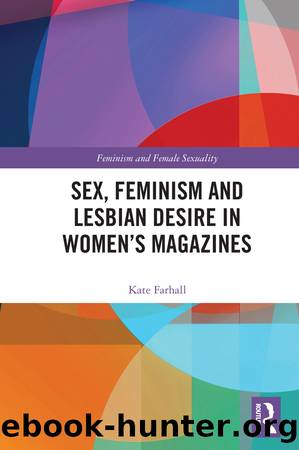Sex, Feminism and Lesbian Desire in Women's Magazines by Kate Farhall

Author:Kate Farhall [Farhall, Kate]
Language: eng
Format: epub
ISBN: 9781000169737
Barnesnoble:
Goodreads: 52647040
Publisher: Routledge
Published: 2020-09-14T00:00:00+00:00
Heteroflexibility and the performance of lesbian sexuality at the turn of the century
Feminist theorists have identified the continued promotion of lesbian chic across various media forms into the 21st century. Feminist psychologist Lisa Diamond (2005, 104) critiques television and film representations of what she dubs âheteroflexibilityâ,10 the representation of âpresumably heterosexual women ⦠experimenting with same-sex sexualityâ, arguing that it in fact serves to reinforce heterosexual dominance by presenting heterosexuality as a personal choice, made outside of any socio-political context. At the same time, Gill (2008, 2009a) notes that the âhot lesbianâ trope has become a popular contemporary advertising tool designed to market lesbian sexuality to a male gaze. Moreover, this marketing of a particular construction of lesbian sexuality for heterosexual male consumption is not confined to popular media, but is also becoming an increasingly common form of sexual practice. Ethnographic and participant-based research suggests that heteroflexibility is common among young women, many of whom perform same-sex eroticism primarily for the benefit of male peers11 (Alarie and Gaudet 2013; Fahs 2009; Hamilton 2007; Jackson and Gilbertson 2009; Lannutti and Denes 2012; Morgan and Thompson 2011; Rupp and Taylor 2010; Yost and McCarthy 2012). Importantly, such performances are also structured through race and class inequalities; in the US college party scene, for example, spaces in which heteroflexibility occurs are often âcontrolled by white menâ and marked by wealth, with strict demarcations around who should participate (primarily white, feminine, conventionally attractive women) (Rupp et al. 2020, 344). In the examples of heteroflexibility within the magazines explored next, the accompanying images similarly mark heteroflexibility as predominantly white and âhotâ. As in the dataset more broadly, women of colour are invisibilised.
This section explores several articles from the 2003 editions of Cleo and Cosmopolitan that either epitomise the trend towards heteroflexibility or provide an important counterpoint. Ultimately, this section argues that articles pertaining to womenâs same-sex sexuality present a performance of lesbianism centred on heterosexuality and male desire, even as it often (ostensibly) excludes them. This re-inscription of heterosexuality onto femaleâfemale sexuality is achieved in several ways. At times, explicit links are made between lesbian desire and male arousal. Yet, even when menâs desire is not explicitly invoked, the framing of articles presents womenâs same-sex sexuality for the male gaze. Heterosexuality is made prominent through emphasising womenâs ongoing heterosexual availability, thus ensuring menâs continued sexual access to women, while heterosexual dominance is further reiterated through the rejection of a lesbian identity by women portrayed as participating in heteroflexibility. Each of these elements of heteroflexibility within the magazines is explored in turn.
Download
This site does not store any files on its server. We only index and link to content provided by other sites. Please contact the content providers to delete copyright contents if any and email us, we'll remove relevant links or contents immediately.
Taming of a Rebel by Eada Friesian(368)
Angel: A Daddy for Summer by Layla Dorine(321)
The Ex-Girlfriend of My Ex-Girlfriend Is My Girlfriend: Advice on Queer Dating, Love, and Friendship by Maddy Court(318)
Embracing Darkness: A Dark MMMM Insta-Romance by N. Slater(314)
A Question of Sincerity by Blaum Sabrina(306)
Nerdy Dirty Valentine by Skylar M. Cates(305)
Over the Hill and Up the Wall by Todd Alexander(305)
What You Get When You Buy A Car in Cornwall: A Cornwall Lesbian Romance (Cornwall Lesbian Romance Series Book 4) by Sabrina Kane(301)
The Birthday Manny by Sammi Cee(290)
Pele's Fire: Phantom Lover 16 by AJ Llewellyn(286)
Sex, Feminism and Lesbian Desire in Women's Magazines by Kate Farhall(264)
In My Dreams (Dreams duet Book 2) by Caz May(256)
Teething by Megha Rao(233)
The Wedding Party by Cathy Kelly(232)
Love Set in Granite by Amy DeMeritt(169)
BABY BANK: A Lesbian Romantic Comedy by Sarah Robinson(167)
Baby Bank by Sarah Robinson(166)
A Girlhood by Carolyn Hays(163)
The Tenacity of the Couple-Norm by unknow(149)
